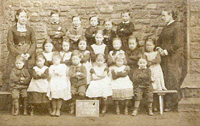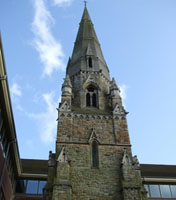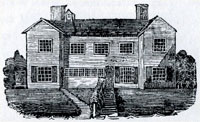
My school days - From dame school to Collyers
Billy was born just three years after Forster’s Education Act of
1870. The provisions of the Act had not been fully implemented by
the time he was old enough to attend primary school and no doubt
his parents would have had to meet at least some of the cost of
that schooling. At just 8 years of age he sat for and passed the
entrance examinations for Collyers, the Horsham Free School. He did
well at Collyers but his parents could not afford to keep him at
school after 12. Collyers came to an arrangement with his parents
which allowed him to continue to attend school on a half-time basis
for the next couple of years while he took on a series of part-time
jobs about the town. After which, aged just 14, he began his
apprenticeship as a “three branch hand” with Sendall Brothers, a
local building firm.
When I was four years old, my mother, having “taught me my
letters”, I went to a little dame school up the bank just west of
the railway bridge over East Street, Horsham. This was kept by an
old lady, Mrs Chambers[1]. It was a
queer sort of school. We all sat round the little room on little
stools with the old dame near the fire trying to teach us to read.
There were about a dozen in the school of varying degrees of
scholarship. Those of us who were more forward were allowed to tend
the fire, chop wood, and take the little ones out the back when
they wished to “leave the room”. I remember this job took the
greater part of my time until it dawned on my mother that I was
really losing the little she had taught me, and what I was gaining
was not worth the 3d a week school fees.
So I was taken away from Mrs Chambers and sent to St. Mary’s Church
School in North Street Horsham, now a Church of England girls
school, then girls and infants. I soon found the difference between
being a big boy in a little school and a little boy in a big one.
The “mixed infants” usually sat on what was called the “gallery”,
the little boys up front being pestered all the time by the bigger
girls at the back of them. The annoyance of these bigger girls in
school was nothing compared with what we were subjected to by the
biggest girls in the playground. These young fiends ranged, I
suppose, from 12 to 14 years. They took a wicked delight in
exploring that part of their anatomy different to theirs and the
function of that part. Their great sport was to get three or four
of us to perform a la the Manikin Pis in Brussels. The term used
was “be fire brigades” and see who could “go” highest up the wall
in the latrine. Those of us whose pressure was for any reason weak
or inefficient were pinched and pulled about by our tormentors who
were yelling with delight, so much so that a teacher would at times
wander across the yard to see what was the matter. She would be
told – “Oh, please teacher, Willie, or Charlie or Peter has been a
naughty boy and wet his knickers”. Teacher, who loathed little
boys, would say, “Oh never mind girls, don’t laugh at him. He is a
very dirty little boy. I’ll send him home with a note to his
mother.” This she did once in my case with a rather unlooked-for
result. Till then, my tailor(my mother) had been content to make a
little slit in the front of my breeches. After my disgrace, it
occurred to her that I might have had some difficulty in the
manipulation necessary and so had my first pair of breeches
buttonholed up “like a man”.
I have among my treasures the one and only school group photograph
that I ever remember.
 St. Mary’s Church School, c. 1879.
Billy Hoad is fourth from the left in the front row.
St. Mary’s Church School, c. 1879.
Billy Hoad is fourth from the left in the front row.
I remember learning to knit very indifferently but little else
until I went to St. Marks School, now the County Library, then a C.
of E. boys school. My principal memories of the school are the
departure of our teacher, Mr Cork, for America. We all subscribed
our pennies to buy him a telescope for which he seemed very pleased
when he said goodbye and caused most of us to weep big salt tears,
for we like him very much, far more than we liked some of his staff
he left us with. [Another memory is] a course of talks on scripture
by Rev Edmund Ellis, then Curate of St Marks. He offered a prize
for the boy who wrote the best paper on these lectures. I won it
and still have it: one of G.W.H. Kingston’s stories, Owen Hartley.
It is inscribed by Mr Willis as “Presented to Willie J. Hoad as a
reward for his knowledge of Holy Scripture, Easter 1879”. I being
then a fairly mature person of 6 years! But that book, which I
loved, did me a power of good. It caused me to work at school, to
the great delight of my mother and at least the approval of my
father who quite rightly rather discounted my profound “knowledge
of Holy Scripture”.
 All that remains of St. Marks
Church, Horsham, the site of Billy’s second school.
All that remains of St. Marks
Church, Horsham, the site of Billy’s second school.
I think I must have got hold of the rudiments of the “three Rs” at
St Marks, for in May 1880, I being just old enough to sit for it,
passed an entrance examinations to what we now know as Collyers,
then called the Free School by all and sundry, but its official
name on book plates etc. was Horsham Free Grammar School, founded
by Richard Collyer 1532. This I gather was some achievement. Many
boys failed; I was three days past 8th birthday. I am sure I became
quite uppish and, I expect, a little prig. This was partly knocked
out of me in the first week. In recognition of my success, my
father and mother bought me the first suit of shop clothes I ever
had, and was I proud of them? Alas, I was yet to be “crowned”, a
wicked ceremony of initiation devised by the bigger boys. First I
was to be blindfolded and made “king of the Golden Sword”. I being
as green as an unripe gooseberry, and possibly a little pleased as
a shy little boy to be made a fuss of. The Golden Sword was a stout
stick that had been stirred round in the open privy, and when
nicely covered in ordure, I was told to grasp it firmly with both
hands. This I did and was led, still blindfolded, to the river
nearby for baptism. I was assured en route that I would not be
chucked in, only spattered with water. Arriving at the river, it
seems that fate had delivered at that very time and place, the
swollen and stinking corpse of an unwanted cat, This the little
beasts fished out and rubbed all over my precious new suit, I being
tightly held all the time. I struggled and finally kicked one boy
rather seriously, broke loose, got hold of the cat by the tail, and
so laid about my persecutors that the master had to send six boys
home during the afternoon class on account of the unbearable
stench. But my new suit! My dear old mother wept to behold me – and
smell me. Two or three washings finally removed most of its
offensiveness, but it was never the same suit. To her eternal
credit, she refrained from her first impulse of raising hell at the
school and, strange to say, I was never once subject to any more
bullying, except being made to fight boys with whom I had no
quarrel; after all, we all do that still in every war!
Looking back, after some experience of schools in the abstract, I
think the old Free Grammar School in my day was, as far as its
means allowed, a good school. It attempted little beyond elemental
education. It was not hampered by “codes” or H.M.I.[2] The only bodies interested, and they only
remotely, were vicar and churchwardens, and the Mercers Company.
During my time at school, I only saw the Vicar there once. He had
run down two boys caught in his orchard. He fixed them by the ear
and brought them to school, explaining to the master “No doubt they
were surprised to find that the Parson could run.” As for the
Mercers Company, well our founder, Richard Collyer, was a Mercer,
and the legend was our examination papers and our “piece books”
were sent to Mercers Hall for the delectation of and appraisement
by the worthy Mercers who worked overtime going through them all
and deciding on prize winners. I believe, in fact, nothing of the
kind happened, but it was simply a centuries old custom to send up
samples of the work of certain boys. These were duly returned with
a remittance for prizes, the allocation of these being left to the
Headmaster. On the whole this system worked pretty well.
 The original Collyers schoolhouse
which Billy attended in Normandy, Horsham. Reproduced with
permission from Hidden Horsham www.hiddenhorsham.co.uk
The original Collyers schoolhouse
which Billy attended in Normandy, Horsham. Reproduced with
permission from Hidden Horsham www.hiddenhorsham.co.uk
The school consisted of 80 boys aged 8 to 14 in theory, 10 to 14 in
practice, divided into four classes, all in one room, with two
teachers, one was called the “master” the other the “usher”. The
master, James Williams[3] – “old
Jimmy” to us – was usher when I entered the school so I was
fortunate in spending all my time with him, as when he became
master, I moved up with him. He was in his spare time Secretary or
Treasurer of all manner of bodies e.g. Horsham Cricket Club,
Horsham and Crawley Co-operative Society, The Mechanics Institute,
the Winter Fund, a consolidated body administering charitable
funds, coals and blankets etc., the Amateur Dramatic Society etc.
etc. The work entailed in all of this was done by top class boys.
All notices of meetings, circular letters, minute books and the
like. Remember, there were no typewriters or duplicating machines,
every letter was written by hand and copied. Every circular letter,
calling a meeting, say of Cricket Club, all snap letters to get a
team together, copies of accounts and balance sheets to lay before
an AGM, all written and copied by perhaps a dozen of us. Also the
stock records of the Co-operative stores, invoice checking, Day
Book, Journal, Ledger, all were written up from “chits” from the
stores. The Society had a branch shop at Crawley, and a highly
prized adventure was to be sent to Crawley by train with one set of
books, and to bring another set back. I well remember now how I
swelled with importance on being entrusted with such a
mission.
A further task was the working out of the dividend for each
customer. The system was, with every purchase one was given a
stamped “check” for the sum spent. At the end of every quarter,
these checks were returned to store, a list of totals were made by
secretary, and we were given the task of working out the “divi”
which varied quarterly from 10d to 1/6 in the pound. There were
hundreds of customers and the job took many days. The results of
the first set of boys were then checked by another set, and finally
counter-checked by a set of eight seniors in the front row. For
every error they found, and there were very few, they were highly
commended by the master and he would check these himself but he
rarely looked at any others. While he commended those who satisfied
him about a mistake, there was no suggestion of reproach or
punishment; he would banteringly refer to the boy who made the
initial mistake as “a person with long ears” and as to the chap who
passed the mistake on the first check, he would musingly wonder if
he could distinguish between “backside and breakfast time”. Jimmy
had a kindly satirical tongue which kept us in order as nother else
could. There was little punishment of any kind meted out by Jimmy.
He would say to a boy, after giving him a good talking to, and
making him feel like a repentant worm, “Now don’t you think you
deserve a good flogging?” “Yes Sir, I’m sorry Sir.” “Well, I’m glad
you agree with me. I’m not sure if you really are sorry, we shall
see, but I am delighted to know you think you deserve a flogging.
Unfortunately, I am very busy just now, and so, as often happens in
life, one does not get his deserts. Go back to your place! Don’t
hinder me any more, but remember, if I catch you on this line (the
delinquents’ line) again this side of April Fools Day, by the Lord
Harry, I’ll bite you!”
I’m not wishing to suggest that Jimmy Williams was an eccentric, or
shared A.S. Neill’s ideas of education, he was essentially a man of
shrewd common sense who knew and understood boys. He had reached
roughly defined ideas on educational methods, e.g. he would pour
scorn on what he called the nonsensical problems in arithmetic book
as “if it takes two men 7½ minutes to eat a yard of tripe, how long
would they take to mow a ten acre field, given enough beer?” He
thought working out the Co-operative dividend, or the batting and
bowling averages of the Cricket Club, or copying our MP’s circular
letter to chairmen of local Conservative Committees was more to the
point and more interesting.
- [1] Frances Chambers
would have been nearly 80 when Willie attended her “school” at 29
East St. She lived with her three middle-aged daughters, the oldest
unmarried the younger two widowed and all three listed as
dressmakers (1881 English Census).
- [2] Her Majesty’s
Inspectorate.
- [3] James Williams was
Headmaster of Collyers from 1883 to 1890. ‘Old Jimmy’ was only in
his mid-forties when Billy started at Collyers. He lived with his
wife and two young daughters in Springfield Road, Horsham (1881
English Census).
Share this
page (third party services may set cookies)